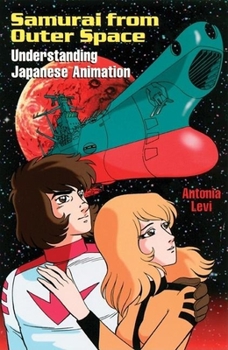Samurai from Outer Space: Understanding Japanese Animation
Samurai from Outer Space is the first book-length discussion of the suddenly popular genre of Japanese animation. Japanese animation, also known as anime (pronounced AH-nee-may), is gaining devoted fans of all ages and nationalities. A few years ago anime was something of an oddity. Now it is poised to become the biggest cultural import since PBS discovered the BBC. There are anime fan clubs on college campuses across the country, as well as anime...
Format:Paperback
Language:English
ISBN:0812693329
ISBN13:9780812693324
Release Date:December 1998
Publisher:Open Court
Length:180 Pages
Weight:0.75 lbs.
Dimensions:0.5" x 6.2" x 9.2"
Customer Reviews
5 ratings
Makes me want to give anime another chance...
Published by Thriftbooks.com User , 21 years ago
I've never liked Japanese animation. I missed out on "Astro Boy" and "Speed Racer" when I was a kid. To me, "Kimba the White Lion" represented Japanese animation. Something about the oddness in the characters voices (they always threw in extra syllables at the end of their sentences, "We have to go save him, huh?") and the gender ambiguity of the lead character (these things are important to uptight pre-pubescent kids) really bothered me. By the time Japanese animation took hold in the US cartoon market with shows such as "Voltron," or "Robotech," I was done with cartoons. By the time Japanese animation started showing up on the shelves at Blockbuster Video, I learned that one should refer to Japanese animation as "Anime." In the years between, I found that the same kind of geeky know-it-all kids who dominated the Advanced Dungeons and Dragons scene and who lingered too long at comic book stores discussing the outcome of a battle between the "Teen Titans" and "Alpha Flight," were the same folks who loved Anime. Have you ever disliked a band because of its fans? This was the same kind of thing. I have yet to listen to anything by The Misfits merely because of all the losers in leather jackets who would come to concerts and stand in my way or push people around in the pit. Nine times out of ten they'd have on some sort of Misfits paraphernalia. No one's written a book explaining the music of the Misfits from an outsider's point of view. Thankfully, Antonia Levy's book Samurai from Outer Space is the perfect guide for jerks like me who've dismissed an entire animation style out of dislike for its diehard fans. Subtitled "Understanding Japanese Animation," Levy takes the reader through the history of Anime and Manga (Japanese comic books). She explains common themes explored in these media, helping to put them into cultural and historical perspective. Levy's book isn't a lofty dissertation on the integration of Shinto myths into modern Anime. While she covers those subjects and more, Levy quickly gets to brass tacks. In her first chapter, she addresses one of my burning questions about Anime and Manga, "Why do these Japanese characters have exaggerated Anglo features?" According to Levy, the characters are not thought of as belonging to any one particular race. Instead, those big round eyes are more of a stylistic flourish of Manga - just as big eyes are trademark in the U.S. to those annoying Precious Moments statuettes.In Samurai from Outer Space, Levy addresses the appeal of Anime and Manga to Easterners and Westerners. More than cheaply made adventure stories, Anime and Manga are often steeped in the rich culture of their homeland, just as U.S. storytellers sweeten their narratives with references or by playing off of common cultural themes. Just as a viewer not entirely familiar with Greek mythology might not get as many laughs watching "Xena: Warrior Princess" as someone who really knows their Homer, without a substantial understanding of Shint
A book on the symbols and stories that are a source...
Published by Thriftbooks.com User , 21 years ago
for anime and manga. Over 160 pages full of information on Shinto, Buddhism, Samurai legends, Japanese art and history and how Japanese animation uses it. Chapters also on the women of anime, death and the afterlife in animation and a glossary of anime terms. Add 20 full color pictures and lots of humor, and you have a not-so-serious study about the subject. Only problem is that the book was first published in 1996 and, while the newest printing was 2001, has not been updated and therefore still outdated.
Very interesting book
Published by Thriftbooks.com User , 24 years ago
Good for me: I'm Italian and I'm doing some studies about otaku in my country: it's useful to understand difference between Usa and Italy, for example about otaku. For me otaku are one of the most interesting youth group: I'm an otaku myself and I would like to discuss about otaku in the world
Brings new perspectives to the table
Published by Thriftbooks.com User , 25 years ago
Surprisingly rich in detailing Japanese cultural references, especially those relating to symbolism and theatrical conventions, this is an intelligent survey of the storytelling aspects of anime. Note that the emphasis is on *story*, not so much on matters of film-making craft. But since anime story construction is so rich, and so uniquely different from western pop-culture forms, that's a worthy focus.
Good, interesting
Published by Thriftbooks.com User , 26 years ago
I believe that Antonia Levi's book is very interesting, expecially for me that I'm very interested in this subject. I would also write a book like this about anime in Italy, and I would contact Antonia to tell with her about this phenomen. Thank you, and congratulation for the site!




